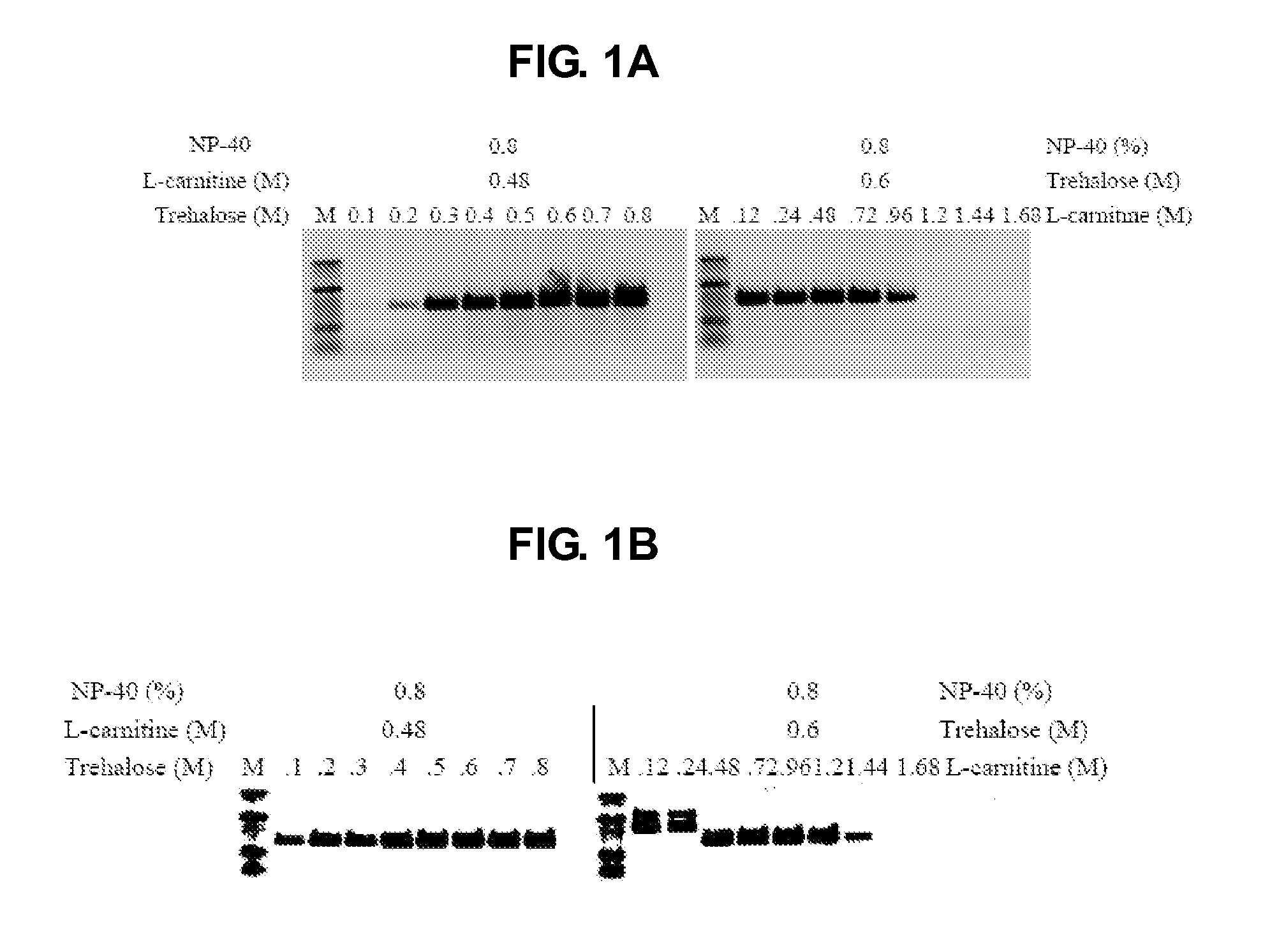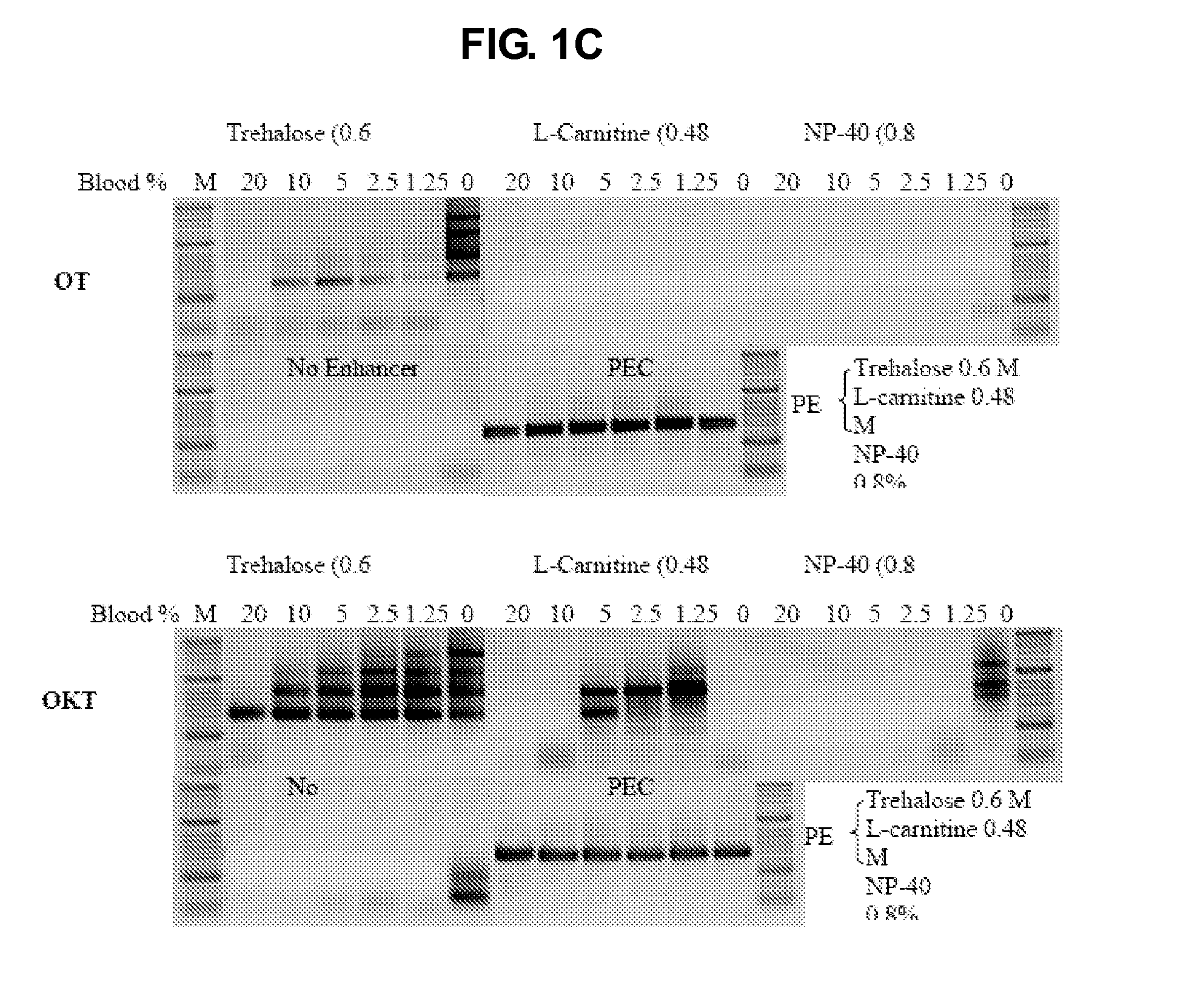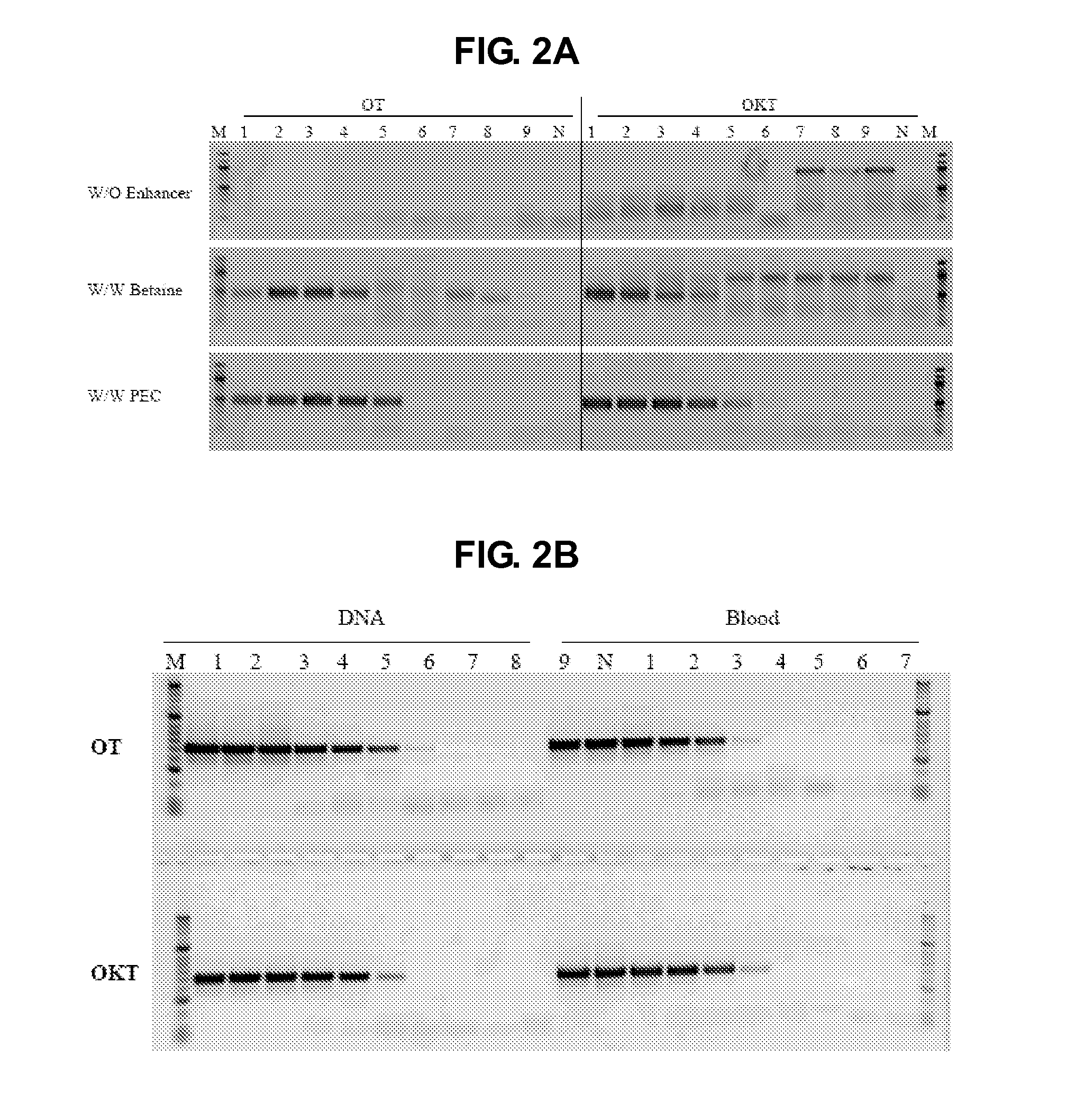Compositions for improving gene amplification
a technology of amplification reaction and polymerase, which is applied in the field of enrichment of direct polynucleotide detection amplification reaction, can solve the problems of high cost and additional labor, limited success and sensitivity of dna detection in important clinical, diagnostic and forensic applications of pcr of blood specimens, and high false negative rate, so as to improve the performance of polymerase enzyme in amplification reaction
- Summary
- Abstract
- Description
- Claims
- Application Information
AI Technical Summary
Benefits of technology
Problems solved by technology
Method used
Image
Examples
example 1
[0134]The following primer oligonucleotideswere used in the PCR reaction to amplify a 630 bp CCR5 target (see e.g., FIG. 1A) and a 488 bp HRES-1-c fragment from 10% whole blood (see e.g., FIG. 1B) or from 0%-25% diluted whole blood (see e.g., FIG. 1C): forward 5′-GCAGCGGCAGGACCAGCCCCAAGATGACTATCT-3′, (SEQ ID NO:1) and reverse 5′-TGGAACAAGATGGATTATCAAGTGTCAAGTCCA-3′ (CCR5; SEQ ID NO:2); forward 5′-TCCGGCCGCGCCACCGCCACCCTCA-3′ (SEQ ID NO:3), and reverse 5′-ACCGCCAGAGCGCCCAGCCCGCGCA-3′ (HRES-1-c; SEQ ID NO:4). The final concentration of each primer was 0.2 μM used in a common master mix. The amount of enzyme used was 2 units per 50 μl reaction. OT was challenged with 10% blood in the presence of different formulations of PEC (see e.g., FIGS. 1A, 1B). OT and OKT were challenged with 0% (4 ng DNA) to 25% whole blood in the presence of trehalose, L-carnitine, NP-40 and PEC, respectively, but the control contained no enhancer (see e.g., FIG. 1C). After 40 cycles the products were analyzed ...
example 2
[0137]The impact of PEC on PCR specificity was assessed by direct amplification of a 488 bp fragment of HRES1-1-c target from blood samples in absence or presence of PEC. 1.3 M of Betaine (Sigma Aldrich, Cat No B0300), a known PCR enhancer, was used as a comparison. Furthermore, the impact of PEC on PCR sensitivity was evaluated by amplifying the same target from both purified DNA and blood. The following primer oligonucleotides were used in the PCR reaction to amplify this target: forward 5′ TCCGGCCGCGCCACCGCCACCCTCA-3′ (SEQ ID NO:3), and reverse 5′-ACCGCCAGAGCGCCCAGCCCGCGCA-3′ (SEQ ID NO:4). The blood sample was a five-fold series diluted from 4% to 0.00001% (see e.g., FIG. 2, lanes 1-9) and the negative control contained no DNA or blood (N). This target (GC content is 81%) was amplified from different concentrations of the blood sample (see e.g, FIG. 2A). Furthermore, this target was amplified from different concentrations of the blood sample or the same amount of purified DNA in...
example 3
[0139]The following primer oligonucleotides were used in the PCR reaction to amplify a 630 bp of CCR5 target and a 488 bp of HRES-1-c from purified DNA (4 ng) and 1.25-25% of whole blood with or without PEC: forward 5′-GCAGCGGCAGGACCAGCCCCAAGATGACTATCT-3′ (SEQ ID NO;1), and reverse 5′-TGGAACAAGATGGATTATCAAGTGTCAAGTCCA-3′ (CCR5; SEQ ID NO:2)); forward 5′-TCCGGCCGCGCCACCGCCACCCTCA-3′ (SEQ ID NO:3), and reverse 5′-ACCGCCAGAGCGCCCAGCCCGCGCA-3′ (HRES-1-c; SEQ ID NO;4). The final concentration of each primer was 0.2 μM used in a common master mix. The amount of enzyme used was 2 units per 50 μl reaction. After 40 cycles the products were analyzed in 1.5% agarose gel electrophoresis (see e.g., FIG. 3).
[0140]Results showed that OT and OKT were only able to amplify the CCR5 target from DNA, but not in blood with the absence of PEC. However, OT and OKT were able to amplify the CCR5 target from both purified DNA and different concentrations of blood in the presence of PEC. OT and OKT were not ...
PUM
| Property | Measurement | Unit |
|---|---|---|
| Fraction | aaaaa | aaaaa |
| Fraction | aaaaa | aaaaa |
| Fraction | aaaaa | aaaaa |
Abstract
Description
Claims
Application Information
 Login to View More
Login to View More - R&D
- Intellectual Property
- Life Sciences
- Materials
- Tech Scout
- Unparalleled Data Quality
- Higher Quality Content
- 60% Fewer Hallucinations
Browse by: Latest US Patents, China's latest patents, Technical Efficacy Thesaurus, Application Domain, Technology Topic, Popular Technical Reports.
© 2025 PatSnap. All rights reserved.Legal|Privacy policy|Modern Slavery Act Transparency Statement|Sitemap|About US| Contact US: help@patsnap.com



